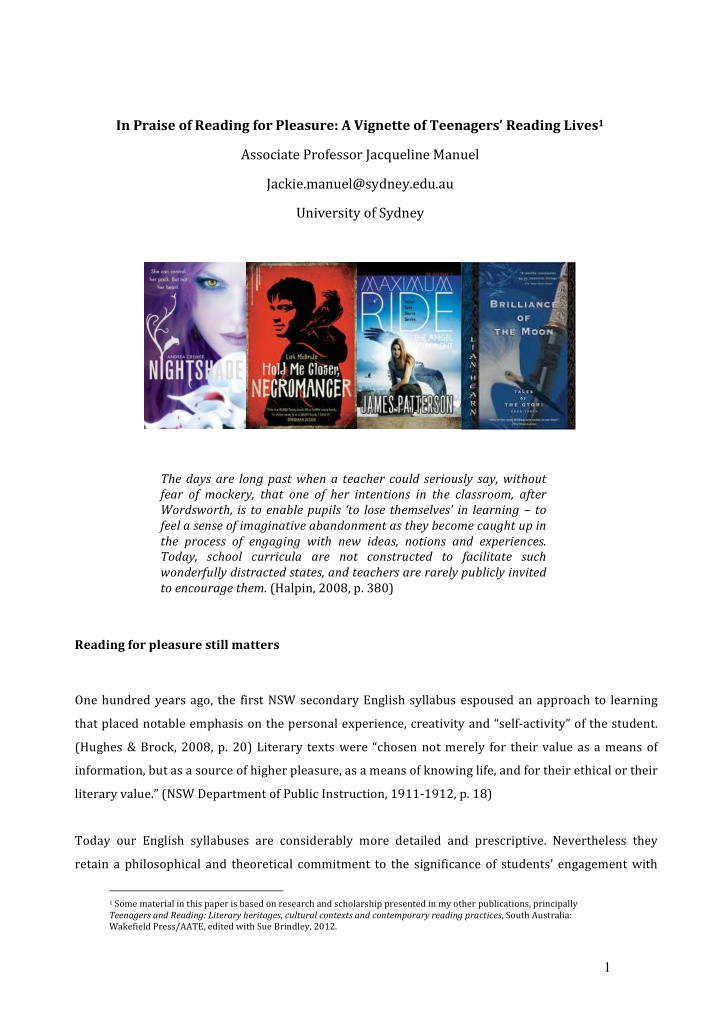



¡ In ¡Praise ¡of ¡Reading ¡for ¡Pleasure: ¡A ¡Vignette ¡of ¡Teenagers’ ¡Reading ¡Lives 1 ¡ Associate ¡Professor ¡Jacqueline ¡Manuel ¡ Jackie.manuel@sydney.edu.au ¡ University ¡of ¡Sydney ¡ ¡ ¡ ¡ The ¡days ¡are ¡long ¡past ¡when ¡a ¡teacher ¡could ¡seriously ¡say, ¡without ¡ fear ¡ of ¡ mockery, ¡ that ¡ one ¡ of ¡ her ¡ intentions ¡ in ¡ the ¡ classroom, ¡ after ¡ Wordsworth, ¡is ¡to ¡enable ¡pupils ¡‘to ¡lose ¡themselves’ ¡in ¡learning ¡– ¡to ¡ feel ¡a ¡sense ¡of ¡imaginative ¡abandonment ¡as ¡they ¡become ¡caught ¡up ¡in ¡ the ¡ process ¡ of ¡ engaging ¡ with ¡ new ¡ ideas, ¡ notions ¡ and ¡ experiences. ¡ Today, ¡ school ¡ curricula ¡ are ¡ not ¡ constructed ¡ to ¡ facilitate ¡ such ¡ wonderfully ¡distracted ¡states, ¡and ¡teachers ¡are ¡rarely ¡publicly ¡invited ¡ to ¡encourage ¡them. ¡(Halpin, ¡2008, ¡p. ¡380) ¡ ¡ Reading ¡for ¡pleasure ¡still ¡matters ¡ ¡ One ¡hundred ¡years ¡ago, ¡the ¡first ¡NSW ¡secondary ¡English ¡syllabus ¡espoused ¡an ¡approach ¡to ¡learning ¡ that ¡placed ¡notable ¡emphasis ¡on ¡the ¡personal ¡experience, ¡creativity ¡and ¡“self-‑activity” ¡of ¡the ¡student. ¡ (Hughes ¡& ¡Brock, ¡2008, ¡p. ¡20) ¡Literary ¡texts ¡were ¡“chosen ¡not ¡merely ¡for ¡their ¡value ¡as ¡a ¡means ¡of ¡ information, ¡but ¡as ¡a ¡source ¡of ¡higher ¡pleasure, ¡as ¡a ¡means ¡of ¡knowing ¡life, ¡and ¡for ¡their ¡ethical ¡or ¡their ¡ literary ¡value.” ¡(NSW ¡Department ¡of ¡Public ¡Instruction, ¡1911-‑1912, ¡p. ¡18) ¡ ¡ ¡ Today ¡ our ¡ English ¡ syllabuses ¡ are ¡ considerably ¡ more ¡ detailed ¡ and ¡ prescriptive. ¡ Nevertheless ¡ they ¡ retain ¡a ¡philosophical ¡and ¡theoretical ¡commitment ¡to ¡the ¡significance ¡of ¡students’ ¡engagement ¡with ¡ ¡ ¡ ¡ ¡ ¡ ¡ ¡ ¡ ¡ ¡ ¡ ¡ ¡ ¡ ¡ ¡ ¡ ¡ ¡ ¡ ¡ ¡ ¡ ¡ ¡ ¡ ¡ ¡ ¡ ¡ ¡ ¡ ¡ ¡ ¡ ¡ ¡ ¡ ¡ ¡ ¡ ¡ ¡ ¡ ¡ ¡ ¡ ¡ ¡ ¡ ¡ ¡ ¡ ¡ ¡ ¡ 1 ¡Some ¡material ¡in ¡this ¡paper ¡is ¡based ¡on ¡research ¡and ¡scholarship ¡presented ¡in ¡my ¡other ¡publications, ¡principally ¡ Teenagers ¡and ¡Reading: ¡Literary ¡heritages, ¡cultural ¡contexts ¡and ¡contemporary ¡reading ¡practices , ¡South ¡Australia: ¡ Wakefield ¡Press/AATE, ¡edited ¡with ¡Sue ¡Brindley, ¡2012. ¡ 1
and ¡enjoyment ¡of ¡a ¡now ¡vastly ¡more ¡diverse ¡and ¡fluid ¡range ¡of ¡texts. ¡And ¡a ¡century ¡on ¡from ¡the ¡1911-‑ 1912 ¡English ¡course ¡of ¡study, ¡our ¡contemporary ¡syllabuses ¡mirror ¡an ¡abiding ¡aspiration ¡that ¡we ¡share ¡ as ¡English ¡teachers. ¡We ¡aspire ¡for ¡our ¡students ¡to ¡become ¡accomplished ¡and ¡confident ¡language ¡users, ¡ receptive ¡to ¡the ¡kinds ¡of ¡satisfactions, ¡pleasures, ¡and ¡intrinsic ¡and ¡interpersonal ¡rewards ¡that ¡can ¡flow ¡ from ¡ an ¡ immersion ¡ in ¡ purposeful ¡ and ¡ meaningful ¡ language ¡ experiences. ¡ When ¡ it ¡ comes ¡ to ¡ reading, ¡ there ¡is ¡a ¡great ¡deal ¡we ¡know ¡about ¡teenagers’ ¡attitudes, ¡their ¡reading ¡practices ¡and ¡preferences ¡and ¡ the ¡accrued ¡benefits ¡of ¡regular ¡reading ¡for ¡pleasure. ¡ ¡ My ¡purpose ¡here ¡is ¡to ¡draw ¡attention ¡to ¡those ¡aspects ¡of ¡research ¡and ¡scholarship ¡that ¡have ¡direct ¡ bearing ¡on ¡our ¡understanding ¡of ¡students’ ¡experience ¡of ¡reading ¡in ¡and ¡beyond ¡the ¡English ¡classroom. ¡ In ¡one ¡sense, ¡this ¡vignette ¡of ¡teenagers’ ¡reading ¡is ¡intended ¡to ¡further ¡validate ¡the ¡often ¡held ¡intuitive ¡ belief ¡ in ¡ the ¡ nexus ¡ between ¡ reading ¡ for ¡ pleasure ¡ and ¡ student ¡ achievement ¡ within ¡ and ¡ across ¡ the ¡ personal, ¡educational, ¡social ¡and ¡cultural ¡dimensions ¡of ¡their ¡lives. ¡As ¡the ¡Report ¡from ¡the ¡Centre ¡for ¡ Youth ¡Literature ¡(2009) ¡states, ¡reading ¡for ¡pleasure ¡matters ¡because: ¡ Reading ¡for ¡pleasure ¡supports ¡literacy ¡and ¡learning ¡in ¡school. ¡ • It ¡enables ¡young ¡people ¡to ¡develop ¡their ¡own, ¡better ¡informed ¡perspective ¡on ¡ • life. ¡ ¡ • It ¡is ¡a ¡safe, ¡inexpensive, ¡pleasurable ¡way ¡to ¡spend ¡time. ¡ ¡ • It ¡allows ¡young ¡readers ¡to ¡understand ¡and ¡empathise ¡with ¡the ¡lives ¡of ¡those ¡in ¡ different ¡situations, ¡times ¡and ¡cultures; ¡to ¡walk ¡in ¡the ¡shoes ¡of ¡others. ¡ ¡ ¡ • It ¡improves ¡educational ¡outcomes ¡and ¡employment ¡prospects. ¡(p. ¡11) ¡ With ¡ this ¡ in ¡ mind, ¡ the ¡ following ¡ discussion ¡ identifies ¡ the ¡ key ¡ findings ¡ of ¡ selected ¡ recent ¡ Australian ¡ research ¡studies ¡and ¡concludes ¡with ¡a ¡summary ¡of ¡the ¡implications ¡of ¡these ¡findings ¡for ¡teaching ¡and ¡ learning ¡in ¡English. ¡ What ¡we ¡know ¡about ¡Australian ¡teenagers’ ¡reading ¡practices ¡and ¡preferences: ¡a ¡snapshot ¡from ¡ recent ¡reports ¡ ¡ From ¡the ¡Centre ¡for ¡Youth ¡Literature ¡Report, ¡2009 ¡ ¡ In ¡2009, ¡the ¡State ¡Library ¡of ¡Victoria’s, ¡Centre ¡for ¡Youth ¡Literature ¡(CYL) ¡published ¡a ¡report ¡on ¡the ¡ reading ¡“landscape” ¡for ¡young ¡Australians ¡(p. ¡2). ¡ Keeping ¡Young ¡Australians ¡Reading ¡presents ¡a ¡rich ¡ amalgam ¡ of ¡ qualitative ¡ and ¡ quantitative ¡ research ¡ findings ¡ for ¡ educators ¡ and ¡ others ¡ involved ¡ in ¡ providing ¡“inspiration, ¡guidance ¡and ¡encouragement ¡to ¡children ¡and ¡young ¡people.” ¡(p. ¡2) ¡Of ¡note ¡are ¡ the ¡findings ¡that: ¡ 2
Recommend
More recommend